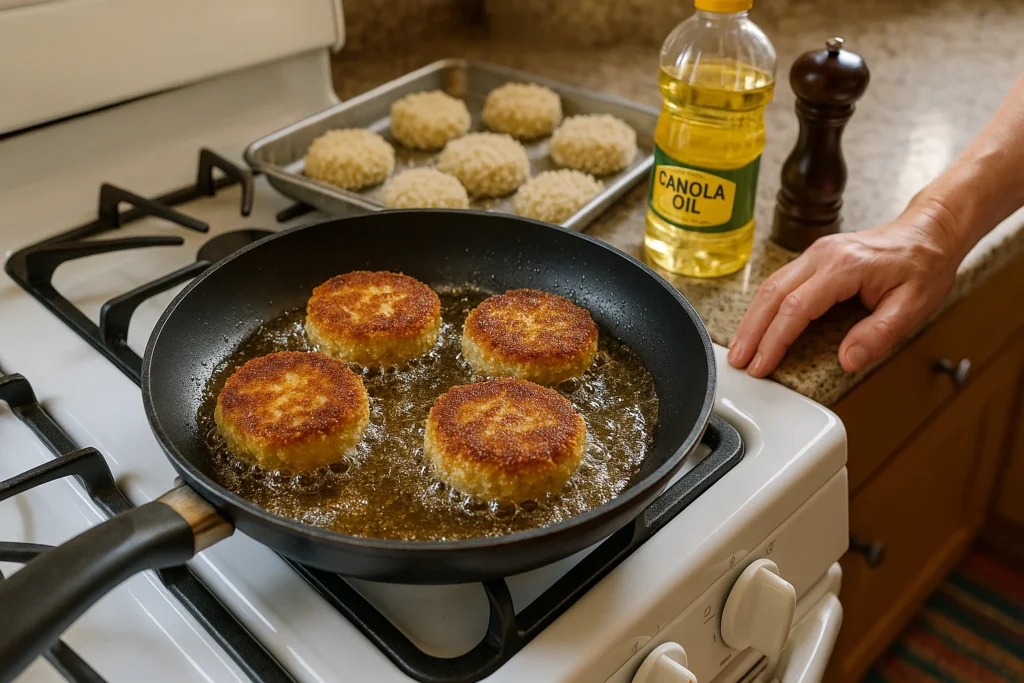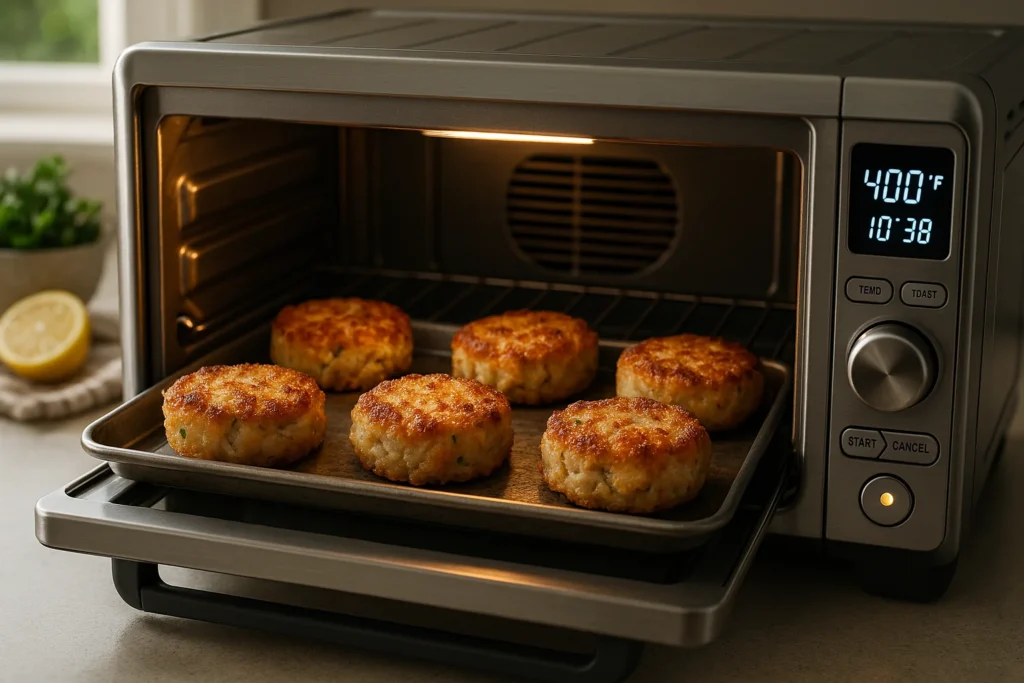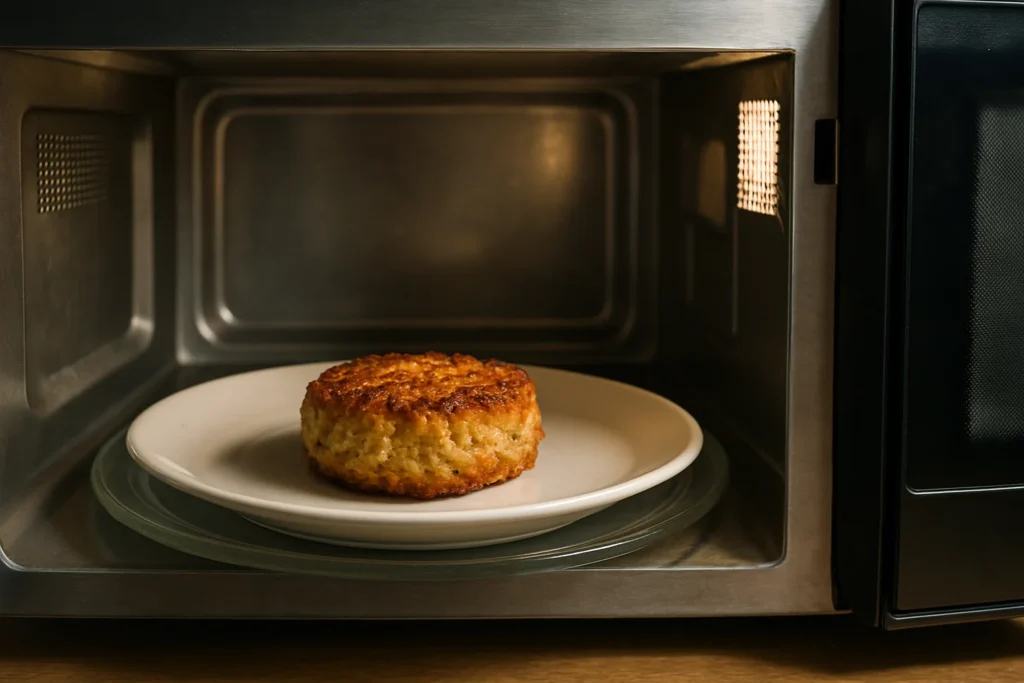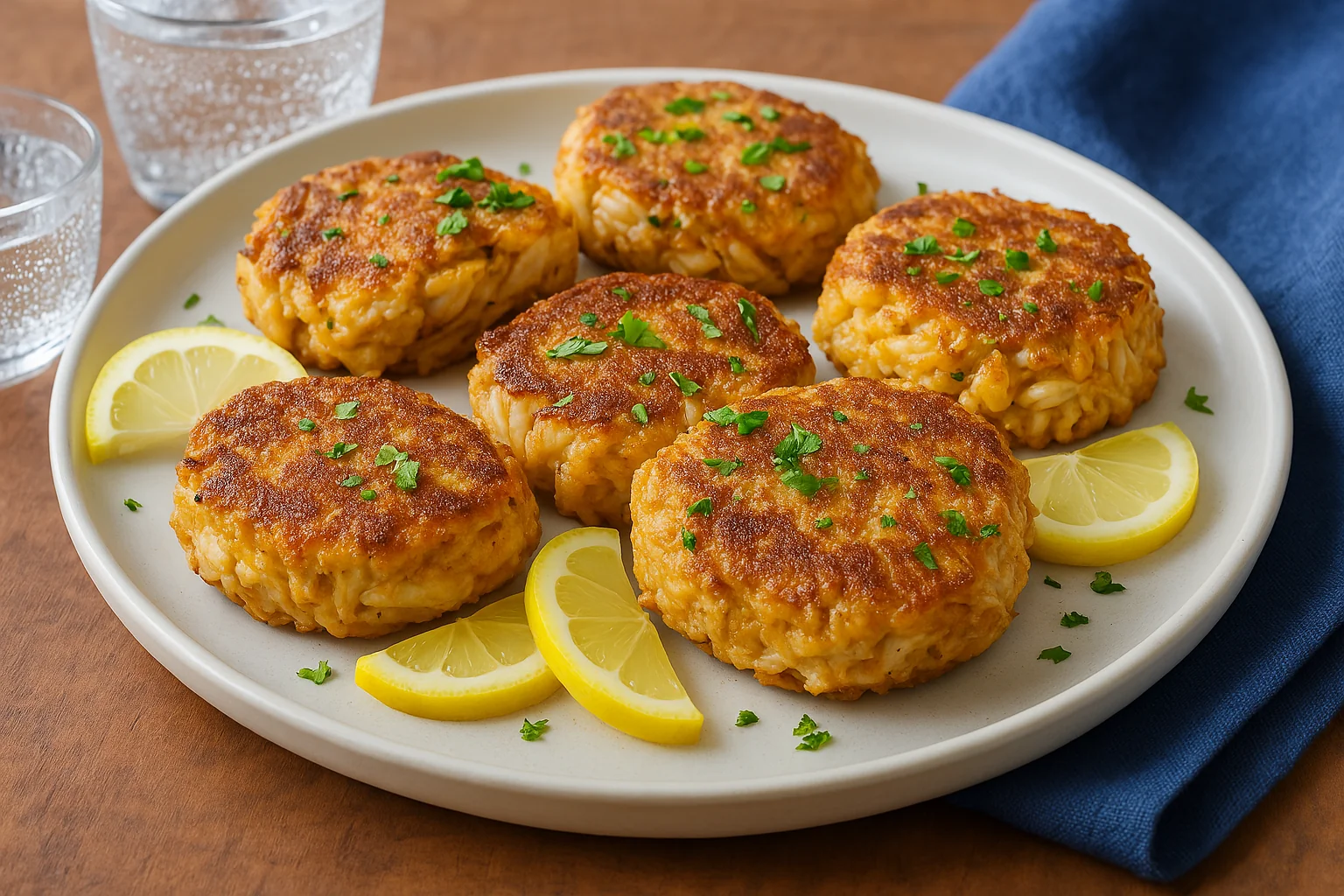🔥 Introduction
Let’s be real—crab cakes are a treat. Whether you splurged on some lump crab meat at a fancy restaurant or made a batch of homemade crab cakes from scratch, the last thing you want is to ruin them when reheating. But here’s the catch: seafood can be notoriously tricky to warm up. Reheat crab cakes the wrong way, and you’ll end up with a dry, rubbery center or a soggy, sad crust.
This post will walk you through how to reheat crab cakes perfectly—without losing that crispy exterior or juicy inside. We’re diving into five tried-and-true methods that work whether you’re using an oven, air fryer, skillet, toaster oven, or (if you must) a microwave. Plus, we’ll tackle the common mistakes that ruin texture, the tools you’ll need, and pro tips to get your leftovers tasting fresh again. Let’s bring those crab cakes back to life—crispy, flavorful, and totally crave-worthy.
📌 Quick Answer: How to Reheat Crab Cakes (Without Losing Crispiness)
To reheat crab cakes without drying them out or getting soggy, use one of these five methods:
- Oven – Bake at 350°F for 10–12 minutes on a parchment-lined baking sheet.
- Air Fryer – Reheat at 370°F for 5–7 minutes, flipping halfway.
- Stovetop – Pan-fry over medium-low heat with oil for 3–5 minutes per side.
- Toaster Oven – Bake at 350°F for 8–10 minutes until hot and crisp.
- Microwave (Caution) – Use medium power for 1–2 minutes with a damp paper towel.
For best results, always use moderate heat and a light brush of oil or butter to keep the crab cakes moist and crisp.
5 Best Methods to Reheat Crab Cakes (Crispy & Delicious)
Reheat in the Oven

If you’re looking for the best way to reheat crab cakes while keeping them crispy on the outside and tender on the inside, the oven is your go-to method. It’s perfect for both homemade crab cakes and store-bought varieties, offering gentle, even heat that revives their original flavor and texture without drying them out.
Here’s how to do it right:
- Preheat your oven to 350°F (175°C).
This temperature is ideal—it’s hot enough to reheat thoroughly without burning the crust or drying out the inside. - Place crab cakes on a baking sheet lined with parchment paper.
This prevents sticking and helps them reheat evenly. For extra crispiness, use a wire rack set on top of the sheet to allow air to circulate underneath. - Lightly brush the tops with olive oil or melted butter.
This small step adds moisture and helps revive the golden crust. Avoid over-oiling, as that can make the cakes greasy. - Bake for 10–12 minutes, flipping halfway through.
Keep an eye on them—if they’re particularly thick, they may need up to 15 minutes. Aim for an internal temperature of 145°F, the safe zone for seafood. - Let them rest for 2 minutes before serving.
This helps the juices redistribute and keeps every bite moist and flavorful.
Pro Tip: Want to avoid sogginess? Place the crab cakes on a wire rack inside your baking sheet instead of laying them flat. This allows the heat to circulate all around and keeps the crust crisp—especially important for jumbo lump crab cakes or breaded varieties.
This method works especially well when reheating multiple crab cakes at once. It’s hands-off, consistent, and gives you that just-cooked taste—minus the mess.
⚡ Use an Air Fryer (Quick + Crispy)
When time is short but texture still matters, the air fryer is hands-down one of the best ways to reheat crab cakes. It delivers a perfectly crispy crust in minutes—without overcooking the delicate crabmeat inside. Think of it as your secret weapon for leftover seafood that tastes freshly made.
Here’s how to reheat crab cakes in the air fryer like a pro:
- Preheat the air fryer to 370°F (188°C)
Just like with an oven, preheating ensures the crab cakes begin crisping immediately. Skipping this step can lead to soggy results. - Lightly coat crab cakes with a bit of oil
Use a brush or spritz of avocado oil or light olive oil to keep the exterior from drying out and help revive the crust. Avoid heavy oils or butter, which can cause uneven browning. - Place crab cakes in a single layer inside the basket
Don’t overcrowd! Air fryers work best with proper airflow, so give each crab cake some space. Reheat in batches if needed. - Air fry for 5–7 minutes, flipping halfway through
This ensures both sides get evenly crispy. Smaller or thinner crab cakes may only need 4–5 minutes; jumbo ones might take a little longer. You’re aiming for an internal temperature of 145°F for food safety and optimum texture. - Let rest for 1–2 minutes before serving
This brief rest helps retain juiciness and keeps the inside from falling apart when you cut in.
Did You Know?
Air fryers work through rapid air circulation, mimicking deep-frying with almost no oil. That means you get the crispy edges you love—without the heaviness or mess of actual frying.
This method is perfect for meal preppers or seafood lovers who want quick results without compromising on flavor. It’s also a great option for reheating store-bought crab cakes, especially those with breadcrumbs or panko coatings, since it revives that signature crunch in no time.
Pro Tip: To prevent the bottoms from getting too dark or dry, place a small piece of parchment paper with perforated holes underneath the crab cakes. This protects the base while still allowing air to flow.
If you haven’t tried this method yet, get ready—reheating crab cakes in the air fryer might just become your new obsession. It’s fast, flavorful, and foolproof.
🍳 Pan-Fry on the Stovetop

If you’re aiming for restaurant-quality results at home, reheating crab cakes on the stovetop is a classic and highly effective method. It allows for precise heat control, revives the crispy exterior, and gently warms the center without overcooking the delicate crabmeat. This method works especially well for homemade crab cakes, where maintaining texture and moisture is key.
Step-by-Step Instructions:
- Choose a nonstick or cast-iron skillet
A nonstick pan prevents sticking, while a cast-iron skillet enhances browning. Either option allows for even heat distribution, which is essential when working with seafood. - Add a small amount of oil or butter
Heat 1 to 2 tablespoons of oil (olive oil, avocado oil, or a mix of oil and butter) over medium-low heat. This not only prevents sticking but also helps restore the crab cake’s crisp exterior. - Place crab cakes in the pan gently
Allow a bit of space between each one to prevent steaming. Overcrowding the pan will lead to uneven heating and a limp texture. - Cook for 3–5 minutes per side
Flip gently using a spatula to avoid breaking them apart. The goal is to warm the interior thoroughly while achieving a golden, crisp finish on both sides. If your crab cakes are especially thick, consider covering the pan loosely with a lid for a minute or two to help retain internal heat. - Check internal temperature
For food safety, ensure the internal temperature reaches 145°F (63°C). You can test this with a kitchen thermometer. - Drain briefly on a paper towel
This helps remove any excess oil and keeps the outside pleasantly crisp—not greasy.
Chef’s Note:
For an extra layer of flavor, consider tossing in a few sprigs of fresh thyme or a squeeze of lemon juice toward the end of cooking. These subtle additions can elevate the taste without overpowering the crab.
Why This Method Works:
Pan-frying gives you direct control over heat and texture, which is especially valuable for delicate foods like crab cakes. Unlike the microwave, this method preserves both the flavor integrity and the structure of the cake. It’s also ideal when you want to reheat just one or two pieces quickly without preheating a larger appliance like an oven or air fryer.
Pro Tip:
If your crab cakes are crumbly or loosely packed, refrigerate them for 10–15 minutes before pan-frying. This helps them hold together better during the reheating process.
With just a bit of patience and the right technique, reheating crab cakes on the stovetop can deliver near-perfect results—crispy, golden edges and warm, tender crab meat that’s as satisfying as the first time around.
🔄 Reheat in a Toaster Oven

For a small batch of leftover crab cakes, the toaster oven offers a smart balance of convenience, speed, and crisp results. It delivers the benefits of a full-sized oven—gentle, even heating and a perfectly crispy exterior—without the lengthy preheat time or energy consumption. It’s especially ideal for meal preppers, singles, or anyone looking to reheat just one or two crab cakes without sacrificing quality.
Here’s how to do it right:
- Preheat the toaster oven to 350°F (175°C)
While toaster ovens heat up quickly, preheating is still important to ensure consistent reheating and prevent soggy spots. - Prepare your baking surface
Line the toaster oven tray with parchment paper or use a small wire rack on top of the tray. The wire rack allows hot air to circulate around the crab cakes, helping them crisp evenly on all sides. - Lightly brush the crab cakes with oil or melted butter
A light coating of olive oil or butter enhances browning and keeps the crab cakes from drying out. Avoid soaking them—just a light brush will do. - Reheat for 8–10 minutes, flipping halfway through
If the crab cakes are especially thick or just out of the refrigerator, add an extra 1–2 minutes. You’ll know they’re ready when they’re golden brown and heated through to an internal temperature of 145°F (63°C). - Let rest before serving
Give them a minute or two to cool slightly, allowing moisture to redistribute and ensuring each bite is juicy, not dry.
Pro Tip:
If your crab cakes seem a bit dry before reheating, place a damp paper towel in a small bowl beside them (not on them) inside the toaster oven. This creates a touch of steam to retain internal moisture—without softening the crust.
Why Use a Toaster Oven?
The toaster oven is ideal for those who want oven-quality results in a smaller footprint. It mimics the dry heat environment of a traditional oven, allowing for crisp reheating without rubbery texture—a common issue when using a microwave. It’s also energy-efficient, making it perfect for quick meals or reheating on busy weeknights.
Did You Know?
Modern toaster ovens with convection settings can function similarly to air fryers. If yours has this feature, turn it on for an even crispier finish.
This method is highly reliable, especially for store-bought crab cakes or any type that has a breadcrumb or panko coating. If you’re looking for a quick, mess-free option that doesn’t compromise flavor or texture, the toaster oven delivers.
⚠️ Microwave (Use With Caution!)

While not the ideal method, the microwave can be used to reheat crab cakes when you’re short on time or don’t have access to an oven or air fryer. However, this method comes with notable trade-offs—namely, the risk of ending up with a soggy crust and an unevenly heated interior. That said, with careful technique, you can use the microwave in a way that preserves both flavor and safety.
Here’s how to do it safely and effectively:
- Place crab cakes on a microwave-safe plate
Use a plate lined with paper towels to absorb excess moisture and help maintain some texture on the bottom. Avoid plastic wrap or covers that trap too much steam. - Cover lightly with a damp paper towel
This step prevents the crab cakes from drying out during reheating. A lightly damp (not soaking) paper towel helps retain moisture without turning the crust to mush. - Microwave on medium power (50–60%) for 45 seconds to 1 minute
High power can overcook the outer layer before the center is warm, so moderate power settings are key. After the first minute, check the internal temperature and continue in 15–20 second increments as needed. - Optional: Finish in a hot skillet for crispiness
If time allows, transfer the crab cakes to a preheated nonstick skillet for 1–2 minutes per side after microwaving. This will restore some of the lost texture and deliver a lightly crisp surface. - Ensure an internal temperature of 145°F (63°C)
Always verify that the crab cakes are reheated thoroughly, especially if they contain eggs or mayonnaise. Use a digital food thermometer for accuracy.
Pro Tip:
Never microwave crab cakes directly from the refrigerator at full power. Doing so often leads to rubbery texture, uneven heating, and a loss of flavor integrity.
When to Use the Microwave
The microwave should be a last-resort method—convenient in a pinch, but best avoided if your goal is to preserve the original texture. It’s suitable for quick lunches at the office, student meals in a dorm, or when you’re only reheating a small portion and have limited kitchen tools.
Chef’s Note:
If your crab cakes have a breaded or panko coating, the microwave will likely soften that crust. When possible, use a hybrid method: start in the microwave, then crisp briefly in a pan or toaster oven for better results.
Bottom Line:
Reheating crab cakes in the microwave can work when necessary, but it requires care and attention. By using the right technique and combining methods when possible, you can preserve moisture while minimizing sogginess. Still, if time allows, consider using the oven, air fryer, or stovetop for superior flavor and texture.
⚠️ Common Mistakes When Reheating Crab Cakes
Even the best crab cakes can fall flat when reheated improperly. These common errors can lead to dry interiors, soggy exteriors, or worse—crab cakes that completely fall apart. Here are the top mistakes people make when reheating crab cakes—and how to avoid them.
❌ Using High Heat
One of the biggest mistakes is cranking up the heat in an attempt to warm crab cakes quickly. While it may seem like a time-saver, high heat can scorch the outside while leaving the center cold or unevenly heated. Worse, it can dry out the crab meat, which is naturally delicate and prone to overcooking.
Pro Tip:
Stick with moderate temperatures—around 350°F for oven or toaster oven reheating and medium-low for stovetop methods. This gives the crab cakes enough time to warm through without compromising texture or flavor.
❌ Reheating Straight from the Fridge
Throwing cold crab cakes straight into a hot oven, skillet, or air fryer can lead to uneven reheating and a disappointing texture. The outside may crisp up too quickly while the inside remains cool, dense, or even cold in the center.
To avoid this, let your crab cakes sit at room temperature for 10–15 minutes before reheating. This small step makes a big difference in even heat distribution and helps preserve the integrity of the crab cake’s structure.
Chef’s Note:
Bringing crab cakes closer to room temp before reheating also helps prevent them from cracking or crumbling apart during the process.
❌ Using the Microwave Alone
While microwaves are convenient, they’re rarely a crab cake’s friend. Reheating crab cakes using only the microwave often results in a rubbery texture and a soggy exterior. This method doesn’t allow for the crisping that makes crab cakes so delicious in the first place.
If you must use a microwave, do so with caution. Use medium power, cover with a damp paper towel to retain moisture, and—if possible—finish in a skillet or toaster oven for crispness.
Pro Tip:
Combine cooking methods: microwave briefly to warm the inside, then pan-sear or air-fry to restore the outer crunch.
❌ Skipping the Oil or Butter
Crab cakes need a touch of fat to stay moist and flavorful during reheating. Skipping this step—especially when pan-frying or baking—can lead to a dry, dull texture, even if the cakes look perfect on the outside.
Use a light brushing of olive oil, avocado oil, or melted butter before reheating. It not only enhances flavor, but also prevents the crust from drying out or sticking to the pan or tray.
Did You Know?
Butter adds richness and helps bring back that “just-cooked” aroma and golden crust that makes crab cakes irresistible.
❌ Not Preheating Your Appliance
Whether you’re using an oven, air fryer, toaster oven, or skillet, starting with a cold appliance is a critical error. A cold surface leads to uneven reheating, longer cook times, and a higher chance of over-steaming rather than crisping.
Preheating ensures that your crab cakes begin reheating immediately upon contact, sealing in moisture and enhancing that crispy exterior.
Pro Tip:
For ovens and toaster ovens, preheat to 350°F. For air fryers, preheat to 370°F for best results. For stovetop methods, heat your skillet for 2–3 minutes before adding the crab cakes.
❌ Covering Crab Cakes Too Tightly
It might seem helpful to wrap or tightly cover crab cakes to retain moisture, but this often leads to the opposite problem: trapped steam softens the crust, leaving you with a mushy, disappointing texture.
Instead, reheat uncovered or with a loose foil tent. This allows steam to escape while still protecting the crab cakes from overexposure to direct heat. If you’re reheating in an oven, placing them on a wire rack helps air circulate evenly around each cake.
Chef’s Note:
The crust is what makes crab cakes special—don’t smother it with foil or plastic that traps moisture.
✅ Final Takeaway:
Avoiding these common mistakes can dramatically improve the taste and texture of your reheated crab cakes. Take your time, choose the right method, and use a few simple pro techniques—and your leftovers will be just as satisfying as day one.
🧰 Best Tools and Ingredients for Reheating Success
Reheating crab cakes isn’t just about method—it’s about having the right tools and ingredients on hand to ensure your results are as close to freshly cooked as possible. From your kitchen setup to finishing touches, here’s everything you need for crispy, flavorful, and restaurant-worthy leftovers.
🍽️ Kitchen Tools You’ll Need
Having the right tools at your fingertips can make all the difference in preserving the texture and structure of your crab cakes while reheating. These essentials help ensure even heat distribution, easy flipping, and minimal mess.
- Air Fryer – Ideal for quick, crispy results. Its rapid hot air circulation crisps the outside while gently warming the interior. Perfect for store-bought or breadcrumb-coated crab cakes.
- Baking Sheet – A standard sheet pan is essential for oven or toaster oven reheating. Line with parchment paper for easy cleanup and even browning.
- Wire Rack – Optional but highly recommended. Elevates the crab cakes above the baking sheet for 360-degree airflow, preventing soggy bottoms.
- Nonstick Skillet or Cast Iron Pan – For stovetop reheating. Nonstick helps reduce oil use, while cast iron offers superb heat retention and browning.
- Tongs or Fish Spatula – Delicate tools like these make flipping crab cakes safer and easier, preventing them from breaking apart.
- Food Thermometer – For food safety and perfect doneness. Reheated crab cakes should reach an internal temperature of 145°F (63°C).
Chef’s Note:
A mini convection toaster oven can often double as an air fryer. If yours has that feature, you’ve got a powerful reheating tool right on your countertop.
🧈 Ideal Oils & Fats to Use
Using the right oil or fat when reheating crab cakes is crucial for moisture retention, flavor enhancement, and surface crisping. Choosing wisely can elevate your reheating results from bland to brilliant.
- Light Olive Oil – Offers a neutral taste with a high enough smoke point for baking or pan-frying. Drizzle lightly or use a brush to avoid sogginess.
- Avocado Oil – Excellent for high-heat reheating (especially in air fryers or skillets). It has a clean, mild flavor and helps promote an even golden crust.
- Butter – Adds richness and a slightly nutty, savory aroma when used during stovetop reheating. Ideal for homemade crab cakes or when a little indulgence is welcome.
- Ghee or Clarified Butter – A great alternative to standard butter that won’t burn as easily under heat. Ideal for pan-frying at higher temperatures.
Important:
Avoid aerosol cooking sprays with propellants, as they can leave a residue on nonstick surfaces and alter the flavor. Instead, use a refillable spray bottle with pure oil for even coverage without additives.
🌿 Fresh Add-Ons to Revive Flavor
After reheating, a few simple garnishes and sauces can brighten and elevate your crab cakes, bringing them back to life with fresh, vibrant flavor.
- Lemon Wedges – A squeeze of fresh lemon cuts through the richness and adds a clean, zesty finish. Serve on the side or drizzle lightly just before serving.
- Tartar Sauce or Remoulade – These creamy, tangy sauces pair beautifully with crab and help compensate for any moisture lost during reheating. Great for seafood lovers who enjoy bold, savory flavor.
- Fresh Herbs – Sprinkle with chopped parsley, chives, or dill for color and brightness. Herbs instantly refresh the palate and enhance presentation.
- Microgreens or Arugula – For a modern touch, serve crab cakes over a small bed of greens. Adds texture, color, and a peppery balance to rich seafood.
- Cracked Pepper or Sea Salt Flakes – A finishing touch that enhances texture and sharpens flavor, especially after reheating.
Pro Tip:
If your crab cakes seem dry after reheating in the oven, place a small splash of water, broth, or even lemon juice under a foil tent during the last few minutes. This creates a gentle steam environment that restores internal moisture without softening the crust.
✅ Final Thought

When it comes to reheating crab cakes perfectly, success is in the details. With the right tools, quality ingredients, and a few pro techniques, you can turn yesterday’s leftovers into a meal that’s crisp, flavorful, and crowd-pleasing once again.
🧠 FAQ: Reheating Crab Cakes Like a Pro
This section is designed to enhance search visibility through long-tail queries, improve user experience, and boost your chances of appearing in featured snippets and voice search results. Each answer is direct, informative, and aligned with the reader’s intent.
❓Can you reheat frozen crab cakes?
Yes, but for the best results, it’s recommended to thaw frozen crab cakes overnight in the refrigerator before reheating. Once thawed, use an oven, air fryer, or skillet to reheat them until the internal temperature reaches 145°F (63°C).
If you’re in a pinch, you can reheat straight from frozen—bake at 375°F for 20–25 minutes, flipping halfway through. The crust may not be as crisp as freshly cooked, but the flavor will still hold up well.
❓What’s the best way to reheat crab cakes without drying them out?
The oven or air fryer are your best bets. Both allow for gentle, even reheating while preserving moisture inside and crisping the outer layer. Use a bit of olive oil or butter, and avoid reheating at high temperatures to prevent dryness.
Pro Tip: Place a small splash of water or seafood broth under a foil tent in the oven to help retain moisture—without steaming the crust.
❓How long do crab cakes last in the fridge?
Properly stored, cooked crab cakes will last 2 to 3 days in the refrigerator. Store them in an airtight container to maintain freshness. If you’re not planning to eat them within that timeframe, it’s best to freeze them to avoid spoilage.
Chef’s Note: Always check for signs of spoilage such as a sour smell, slimy texture, or discoloration before reheating.
❓Can you reheat crab cakes more than once?
Technically, yes—but it’s not recommended. Each reheating cycle degrades the texture and flavor while increasing the risk of bacterial growth. For best results, reheat only what you plan to eat and store the rest properly.
❓What’s the safe internal temperature for reheated crab cakes?
Reheated crab cakes should reach an internal temperature of 145°F (63°C), as per FDA seafood safety guidelines. Use a digital kitchen thermometer to ensure safe consumption, especially if the crab cakes contain eggs or mayonnaise.
❓Is it better to reheat crab cakes in an air fryer or oven?
Both are excellent methods, but they serve slightly different needs:
- Air Fryer: Best for speed and crispiness. Ideal for small portions or single servings.
- Oven: Great for reheating multiple crab cakes evenly. Offers more control and flexibility for different thicknesses or fillings.
Choose based on convenience, portion size, and available tools.
Conclusion
Crab cakes are a culinary favorite—but reheating them can be tricky without the right approach. Whether you prefer the oven, air fryer, skillet, or even a toaster oven, the key is using moderate heat, a bit of oil or butter, and avoiding the common mistakes that lead to sogginess or dryness. Now that you know how to reheat crab cakes perfectly, you can enjoy leftovers that are just as crispy, flavorful, and satisfying as when they were first made.
With a few simple tools and smart reheating techniques, you’ll never settle for mushy crab cakes again. Save this guide, and turn your seafood leftovers into a next-day meal worth craving!
👨🍳 Chef’s Final Note
Great crab cakes deserve great care—even when reheated. Whether you’re working with a batch of homemade beauties or leftover takeout, using the right method can make all the difference. Don’t rush it. Respect the texture, control the heat, and revive them with a little oil and patience. Your taste buds will thank you.
Remember: leftovers are only as good as the love you put back into them. 🔥
Bon appétit!


1 thought on “How to Reheat Crab Cakes Perfectly-5 Easy Methods That Keep Them Crispy”